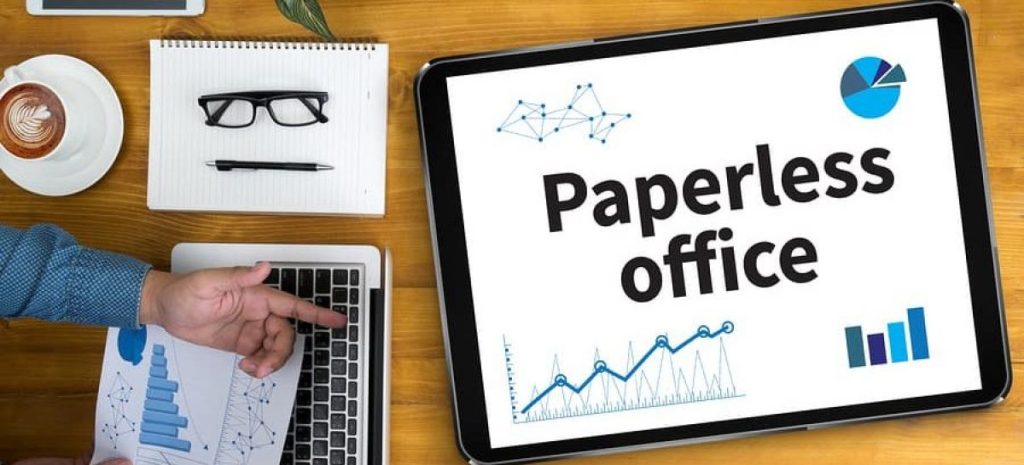
Business owners worldwide are adapting their processes to better suit the needs of the modern workplace, with many opting for a paperless office. However, this involves more than just discarding physical records. Instead, it’s a transition to digital software, like electronic invoicing platforms and document management systems, to improve efficiency, boost security and make businesses more sustainable in their day-to-day operations.
We’ll offer straightforward steps for going paperless and share best practices for creating a document management strategy that reduces paper usage.
Editor’s note: Looking for the right document management system for your business? Fill out the below questionnaire to have our vendor partners contact you about your needs.
How to create a paperless office
Here are a few easy steps for setting up a paperless office.
Provide tools and training for staff.
Don’t assume that your employees will automatically discover and implement ways to minimize their paper usage. They need clear instructions and guidance. Create written guidelines and procedures they can follow to ensure a paperless office.
Make it easier to work without paper.
The paperless process must be easy to implement and deliver benefits. Your team should recognize and enjoy these benefits of a paperless system:
- Easier filing
- Easier and faster retrieval of scanned and sensitive documents via cloud storage
- Easy file sharing without reliance on copying or scanning
Move or remove printers and copiers.
If printers are still easy for your team to access, they will continue to be used. However, you can limit their use by removing them from desktops and replacing them with centralized network printers in dedicated areas of the office.
Additionally, enable logging and password access to make printing secure when absolutely necessary. This functionality also allows management to track usage and address excessive use. You can institute policies that restrict ink and toner purchases to approved devices, which can further curtail the use of printers on employees’ desks.
Devise a new paperless filing system.
Document management software simplifies the digitization process by ensuring that forms are correctly recorded, organized and accessible for future reference.
“This is where a [document management solution] is most helpful,” said Larry Oliver, president of FileHold Systems Inc. “[It can] capture the scan, automatically add metadata and custom naming, and make the document 100 percent searchable.”
The best document management software for your business will depend on the features and functionalities you need. Businesses should explore their options carefully, as implementing the wrong system can disrupt employee productivity and delay staff buy-in during the transition. Consider taking advantage of free trials and demos to ensure you select the right solution.
Once you choose a system, establish a clear workflow to ensure documents move smoothly through the organization for electronic review and approval. “That is the productivity gain and will encourage users to embrace the system,” Oliver said.
Switch from file cabinets to digital storage.
As part of the switch, you’ll need to add networked storage capacity, backup systems, and automated online backup and cloud computing systems. Your computerized filing system can be more secure than paper because documents remain accessible even in a disaster, and scanned documents uploaded to your paperless system require a password for access.
Enable digital scanners.
Modern shared copiers include a document scanner capable of scanning paper documents and storing them in many digital storage and cloud computing systems. Work with your office copier vendor to make your copier and document scanner part of your paperless office. Additionally, ask your copier vendor (or a copier service) about setting up a digital scanner that integrates with an online faxing service.
Integrate the system with business operations.
Employees should be able to file their original documents directly within the software they use to create company documents. Connect their Microsoft Office account, or whatever other software you use, to the document management software you implement for both saving and retrieving files. This way, you can automate your company’s workflow, store paperless documents efficiently and implement digital signature tools, all within a single platform.
Replace fax machines.
Use online fax services to avoid the print-then-fax process. These services can integrate with your office software, enabling direct inbound and outbound faxing from users’ computers. This setup eases the transition to paperless statements and digital signature tools, thereby supporting a fully paperless workflow.
Use e-signature software.
In business, many documents require a signature. Numerous software options allow you to create and use legal, valid signatures on contracts or legal documents. Using e-signatures is more secure and drastically reduces the amount of storage you’d need to keep physical copies of signed documents in the office.
Make your finance department digital.
Paper documents are wasteful and can pose a security risk. Many cloud-based systems offer analytics, tracking and invoicing, and they can be shared across finance and human resources departments, providing additional insights to improve operations.
“By adopting [a] more digitized strategy, businesses are able to gain real-time visibility into processes; make faster, data-driven decisions; and, more importantly, safeguard their company’s future in a rapidly evolving digital economy,” said Kolleen Doucette, vice president of corporate development at DocuPhase.
Additional ways to reduce your paper usage
If you’re convinced going paperless is right for you, take these additional steps to establish your paperless office.
Use cloud storage corresponding with your email accounts.
The platform that manages your company’s emails likely also offers cloud storage options. For this reason, Doucette recommended investing in scalable automation tools tailored to your team’s specific workflows. By ensuring that all digital documents are uploaded to a cloud storage service with integrated automation, you and your colleagues can access all of your documents digitally, securely and safely, no matter where you are.
“An ideal vendor partner should offer end-to-end support throughout the digitization process,” Doucette noted.
Switch to laptops and tablets.
Going paperless is more challenging if your company primarily uses desktop computers. Employees with desktop computers can’t bring their devices to meetings, so they often need to print documents for reference. However, if they use laptops and tablets, employees can connect to projectors or other displays, allowing everyone in attendance to view the materials without needing printed copies.
Set goals and timelines for incremental change.
Lay out a timetable for your office’s transition to a paperless arrangement, and set a date for reaching your target reduction in paper use. Set an initial goal to reduce printing and paper use by some percentage by a certain date. A 50 percent reduction is a good starting place, and an 80 percent reduction is a realistic final goal. Track your progress regularly, and adjust operations as needed.
“Start with areas where digitization will have the highest impact, such as accounts payable and finance operations,” Doucette suggested. “Focus on automating repetitive, manual tasks — like approvals and routing — and don’t try to digitize everything at once.”
Benefits of a paperless office
Although transitioning to a paperless office might not happen overnight, the change can be well worth the effort. Consider the following benefits of going paperless:
- Lower costs: Paper, ink, toner and printer maintenance costs add up. You can save money in the long run by converting to a paperless office, or at least a nearly paperless office with one centralized all-in-one printer. Plus, many cloud storage solutions, such as Evernote, are highly affordable, making it easy for your employees to access all the documents they need anytime, on any device. “Businesses that transition to fully automated, digital processes can reduce operational costs by up to 70 percent, particularly in areas like document handling and invoice processing,” Doucette said.
- Secure access: A paperless office enables your employees to access your company’s documents anytime and from anywhere, as long as they have the necessary login credentials. A strong username and password can offer greater security than a traditional file cabinet, keeping your most sensitive documents safe.
- Increased office space: Printers and file cabinets occupy precious office space. Going paperless removes these bulky items, freeing up valuable space for other needs.
- Workflow automation: Gone are the days of digging through a file cabinet to find the appropriate document. With electronic document management, you and your colleagues can quickly sort through files in just a few clicks to find exactly what you need.
- Paperless statements: A paperless office means minimizing incoming mail, too. Instead of sorting and organizing stacks of invoices, your team can download paperless statements and save them to the appropriate digital folder. If your business creates invoices, going paperless reduces postage costs. You could also replace your business’s cash registers with a digital POS system, further reducing the amount of paper used for receipts.
- Time savings: With a paperless office, employees no longer have to spend time organizing, filing and searching for physical documents. Instead, they can use that time for more productive, revenue-generating tasks. A digital document management system keeps files organized and allows for easy document searching.
- Faster information transfer: Document management software makes it easy to save and collect documents using tools such as scanners and photo capture apps on smartphones and tablets. These systems also allow you to import various document types and integrate with document creation software, such as Adobe Acrobat and Microsoft Office.
- Decreased environmental impact: A paperless office can reduce your business’s carbon footprint. Every business causes carbon emissions to some degree, but going paperless means your company can easily eliminate a significant driver of its environmental footprint. The creation of paper leads to the production of greenhouse gases and deforestation. Additionally, discarded paper often ends up in landfills, where harmful ink and toner can further damage the environment.






